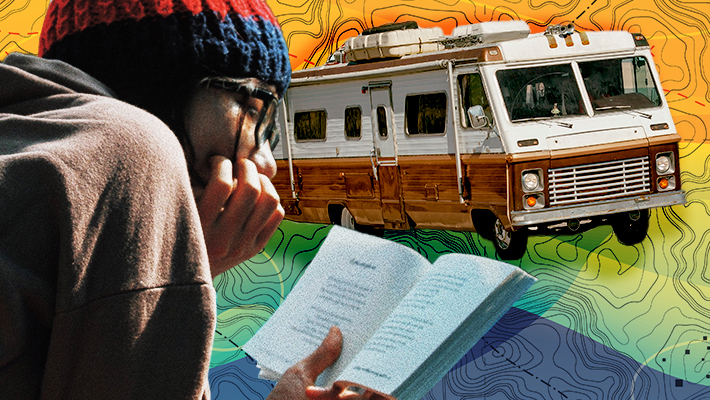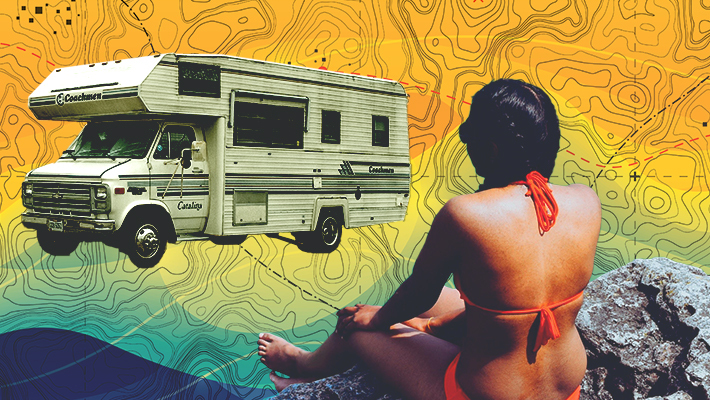Let’s be clear about something. Not traveling in the middle of a pandemic is not a travesty. It’s an inconvenience. It’s a bummer. Having someone die because you flouted social distancing guidelines, that’s a travesty. And if you do flout the guidelines someone could die. Those are the stakes of the conversation at hand.
Any talk of travel right now is set against the backdrop of a global pandemic. With that comes a wide-range of concerns. Not just about how you view the need for caution but also how the people in the place you’re going view it. My friends and family in Portland, Oregon — where they’ve been particularly successful at flattening the curve — aren’t thrilled about the prospect of inbound travelers right now. Especially those coming from neighboring California, which saw a recent spike in cases (though it’s currently trending downward).
It would be nice to think we’re all in this together and the nation is therefore wide open for internal roaming. But that ignores the fact that certain parts of the country perceive the urgency of the threat differently. Just look at Huntington Beach, where people wearing masks are routinely harassed.
So does that mean absolutely no travel? I don’t think so.
While there’s no commonly accepted algorithm to judge who is and who isn’t nailing this whole “being a non-trash person during the pandemic” situation, “points of contact” appears to be a better metric than more arbitrary factors like “miles traveled” or “state borders crossed.” Certainly according to the epidemiologists and public health experts we’ve spoken to. It’s wrongheaded to make a blanket statement that someone staying in their home city but testing the waters with restaurants and bars would be creating/ accepting less risk than someone driving a few hours to a different county (with a similar net positivity rate), while simultaneously observing stricter distancing measures.
COVID has been complicated, but it has rarely defied the rules of logic. Close quarters are worse than open spaces; masks are more effective than not masks. Limited travel, within the right parameters, seems do-able.

Of course, it’s only ethical to travel if you’re willing to do it right. And that’s a big “if.” It requires commitment. Energy which — depending on why you travel and your goals in taking a trip — might potentially bleed some of the fun out of the whole experience. A COVID-era trip can’t be the sort of wild bacchanal that we giddily hyped up pre-pandemic. It’s not likely to feature enriching cultural exchange. But while a trip right now might not be as spontaneous or mind-expanding as what you’re used to, it can be every bit as joyous. Every bit as full of wonder.
In the process, it might just be able to let some of the steam out of this pressure cooker of a situation we all find ourselves in. (Remember that stress during the pandemic is so significant that the World Health Organization (WHO) has a page dedicated to managing it.)
“After someone spends a few days on the road you can see that a weight has been lifted,” says Gretchen Bayless, co-founder of Roamerica, where she rents vans and helps travelers plan no-contact road trips. “The rules haven’t changed, people are still being incredibly strict, they’re still social distancing, they’re still staying within a single tank of gas from home… but you can tell that they needed some sort of reprieve.”
Roamerica operates out of Oregon and asks guests to do their shopping near their homes, rather than adding another contact point to their trips. For my own adventure, a visit to the Kern River — about four hours from my house in Orange County (with a similar COVID net-positivity rate) — I first planned on following that advice and going full-on zero contact. But the day I hit the road, I tweaked that approach ever so slightly. In general, the ethics on pandemic travel are mushy, but it felt strange to me to visit a place during this financially agonizing time and add absolutely nothing to the local economy.
In the end, I decided to buy my fishing tackle in Kernville, with a mask on (though it quickly became clear that wasn’t the local standard). Since the fishing store also had a meat counter, I ended up getting a steak. (An indictment of my angling skills, if ever there was one.)

So what about the travel bit? Was a low-contact road trip actually any fun?
Absolutely. I was alone with a two-year-old, but the main pieces of a classic car adventure were all there. We argued about music, peed along the side of the road when someone had to go, and stopped off for swims (or complained theatrically) when one of us got too hot. We pumped our own gas, as per the California standard, and I sanitized my hands afterward (which I probably should have been doing all along).
The Kern River is fed by snowmelt and winds through Sequoia National Park and a shockingly scenic canyon before being diverted to water the vast farmlands of California’s Central Valley. The drive into the canyon, from the flat, hot town of Bakersfield, is worth the trip alone. Once you pass Lake Isabella — where the river takes a brief, sun-scorched sojourn — and the blink-and-you’ll-miss-it town of Kernville, you reach a long stretch of virtually unregulated wild space. Camping is first-come, first-served and facilities are nonexistent. The river is the lone hub of activity and the diversions are incredibly compact.
The afternoon we arrived on the Kern, my son and I swam, hiked, and fished in the few hours between 5 pm and sunset. He caught his first trout, then promptly screamed until it safely was back in the river. The next day, we went on a longer hike, fished without an ounce of luck, dove off of a log into a crystalline swimming hole, and slid down natural rockslides that could rival any waterpark in America.
I carried a mask at all times, but never wore it. There were no people to infect or be infected by. The only person we actually met in three days was a skinny, scraggly-bearded gold panner who had come down from some secret creek in the hills to get a proper wash in the river and buy supplies with gold dust. The man was all whiskers and jutting bones, with skin turned leathery by the sun. The curiosity of seeing him compelled me to spark up a conversation from ten-feet downstream — not just because he cut such an odd figure but also because chit chat with strangers is the aspect of travel that I found myself missing the most.
The man exchanged a few pleasantries while bobbing in the river near our camp, but wasn’t much of a talker. He wasn’t following the pandemic news and looked fully feral. When I asked one too many questions about his profession, he closed his mouth dramatically and slinked into the undergrowth. (Later research confirmed the one bit of information I got from this strange character — the Kern River and its surrounding tributaries are some of the foremost gold panning locations left in the lower United States.)
Coming back through Kernville on the last day of the trip, I can’t say I wasn’t tempted to drop in at the new(ish), much raved-about brewery in town. People were outside when our car passed, chatting happily and eating nachos, but I decided the juice wasn’t worth the squeeze. I haven’t sat down at a restaurant or brewery back home yet, why test it while on the road? Instead, I settled for ice cream for the kiddo from a walk-up window. Plus, this way he had something to spill on my seats when we got back in the car and headed home.
After nearly two-decades spent roaming this planet, I continue to believe in the deep significance of travel. Most fundamentally, I believe in it in the Bourdainian sense — as a method of connecting people and bridging cultural gaps. But this trip wasn’t that at all. Besides the gold miner and two cashiers, I literally didn’t say a word to anyone but my son.
But I also love the kinetic energy of travel. The propulsive verve it carries. And this trip had that in spades. It offered the respite that Gretchen Bayless spoke about. A chance to change settings without significantly posing a risk to the lives of others. A reminder of the world outside my door and an opportunity to recharge as the quarantine drags on.
For now, that variety of travel is just about all we can (or should) realistically ask for. And it’s plenty good enough to tide me over until full-fledged trips are back on the table.







